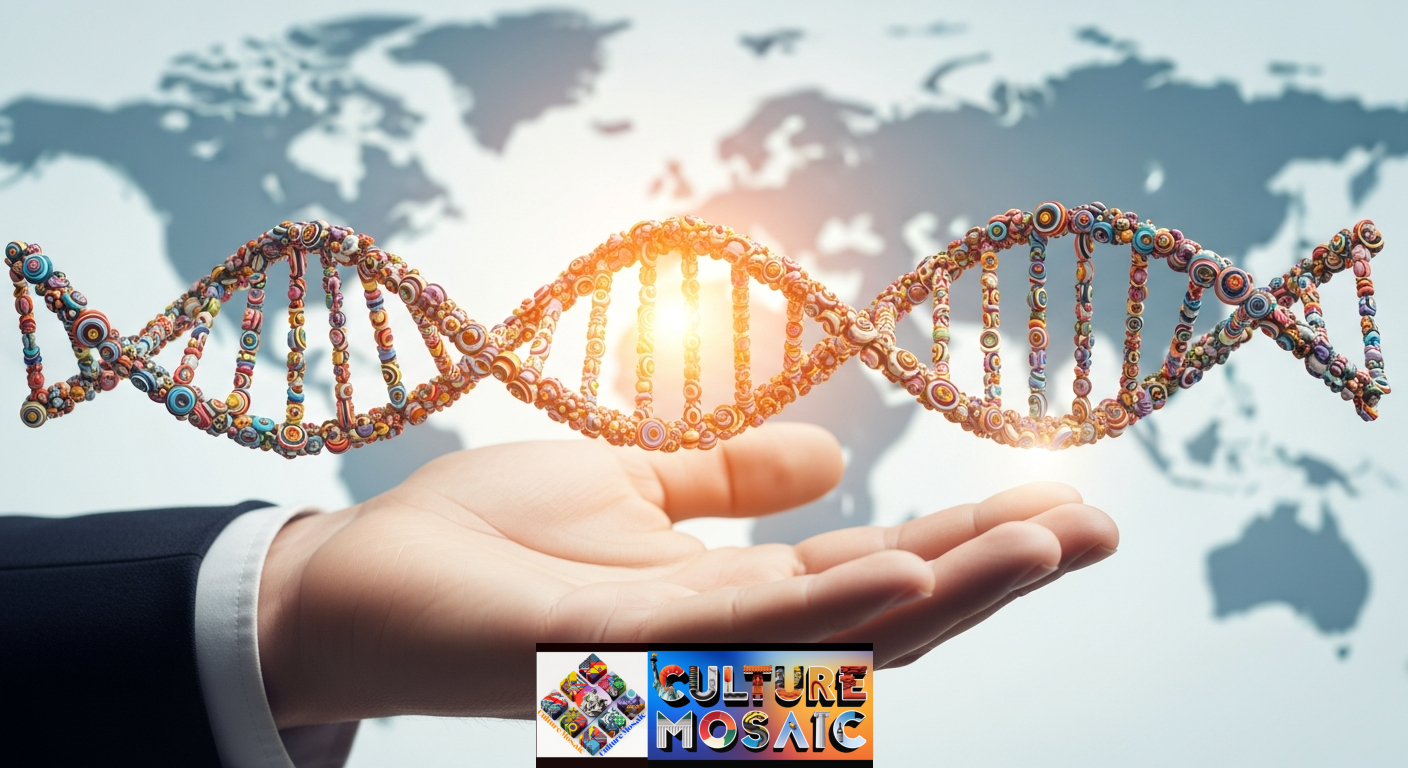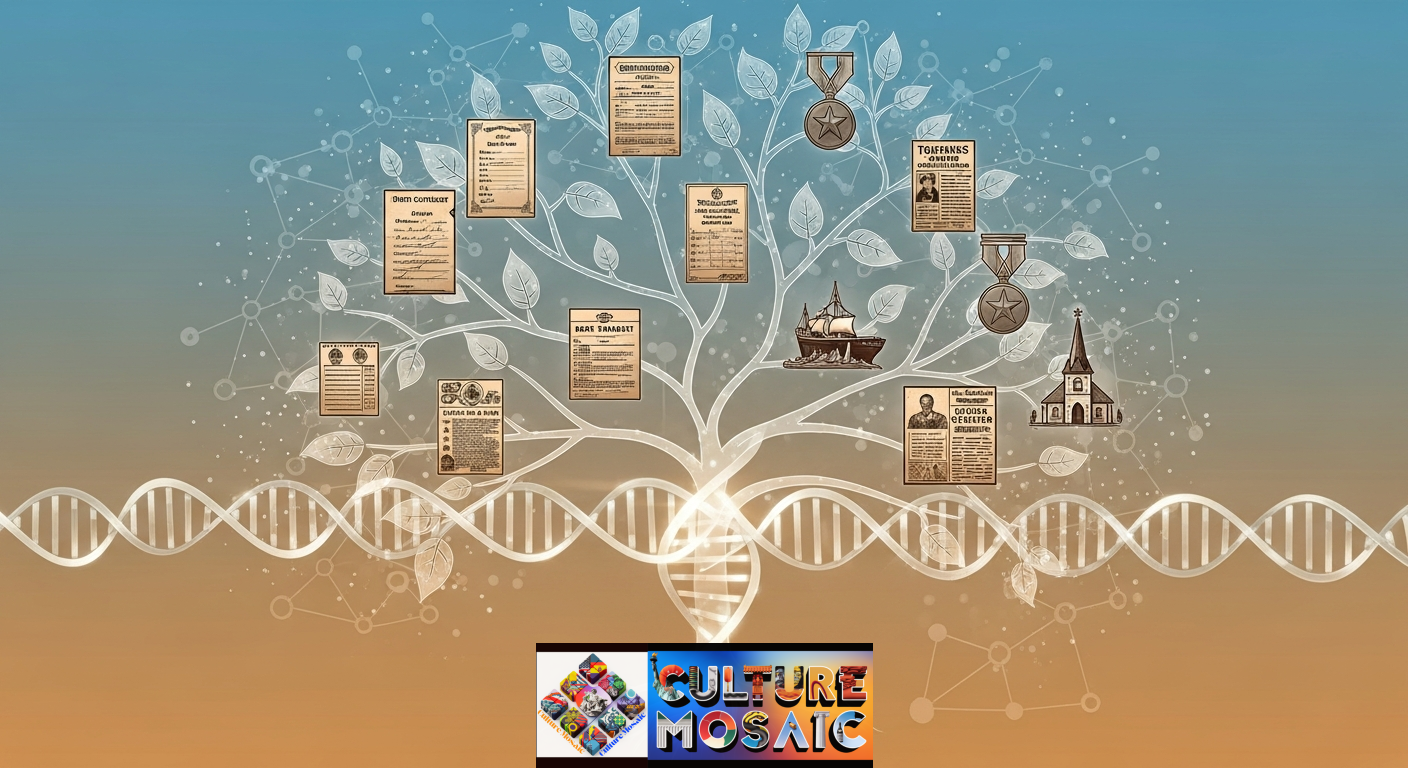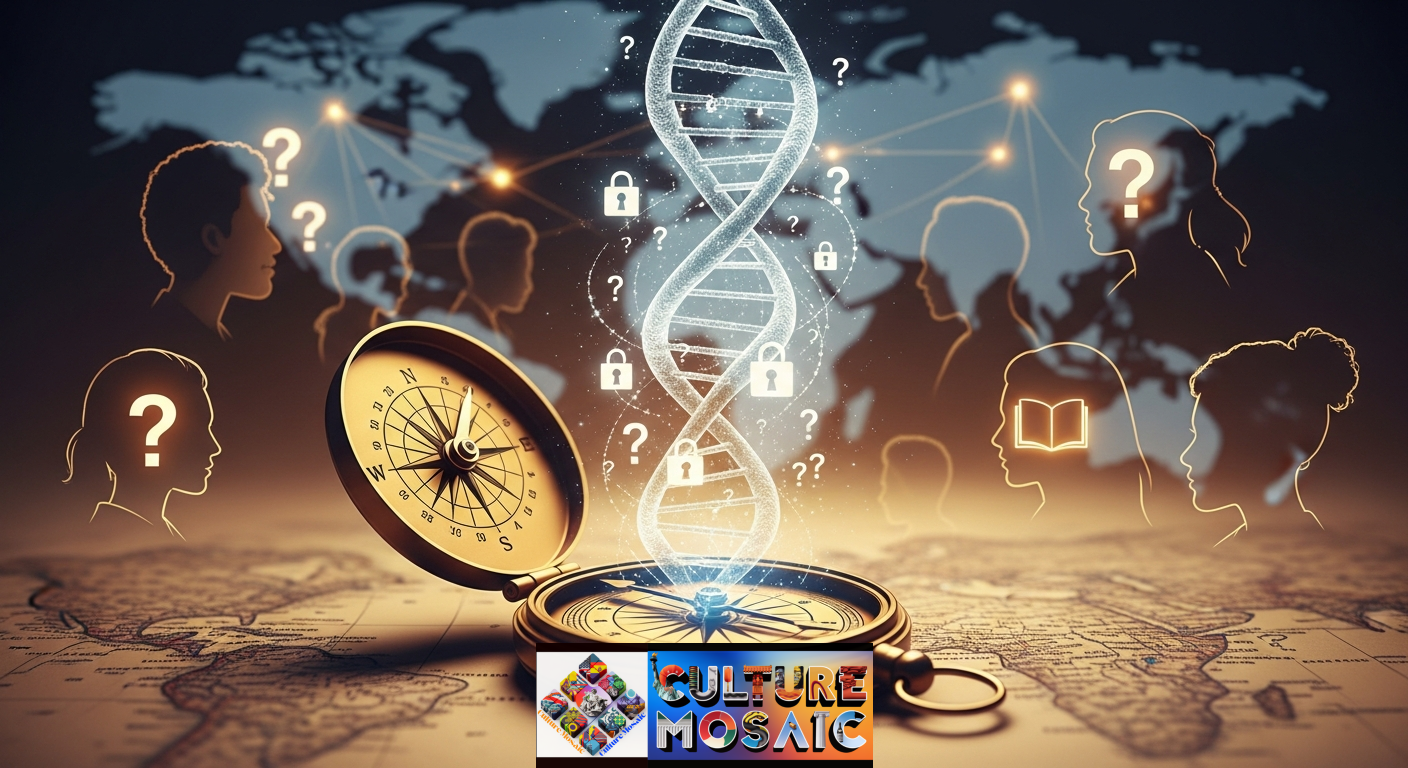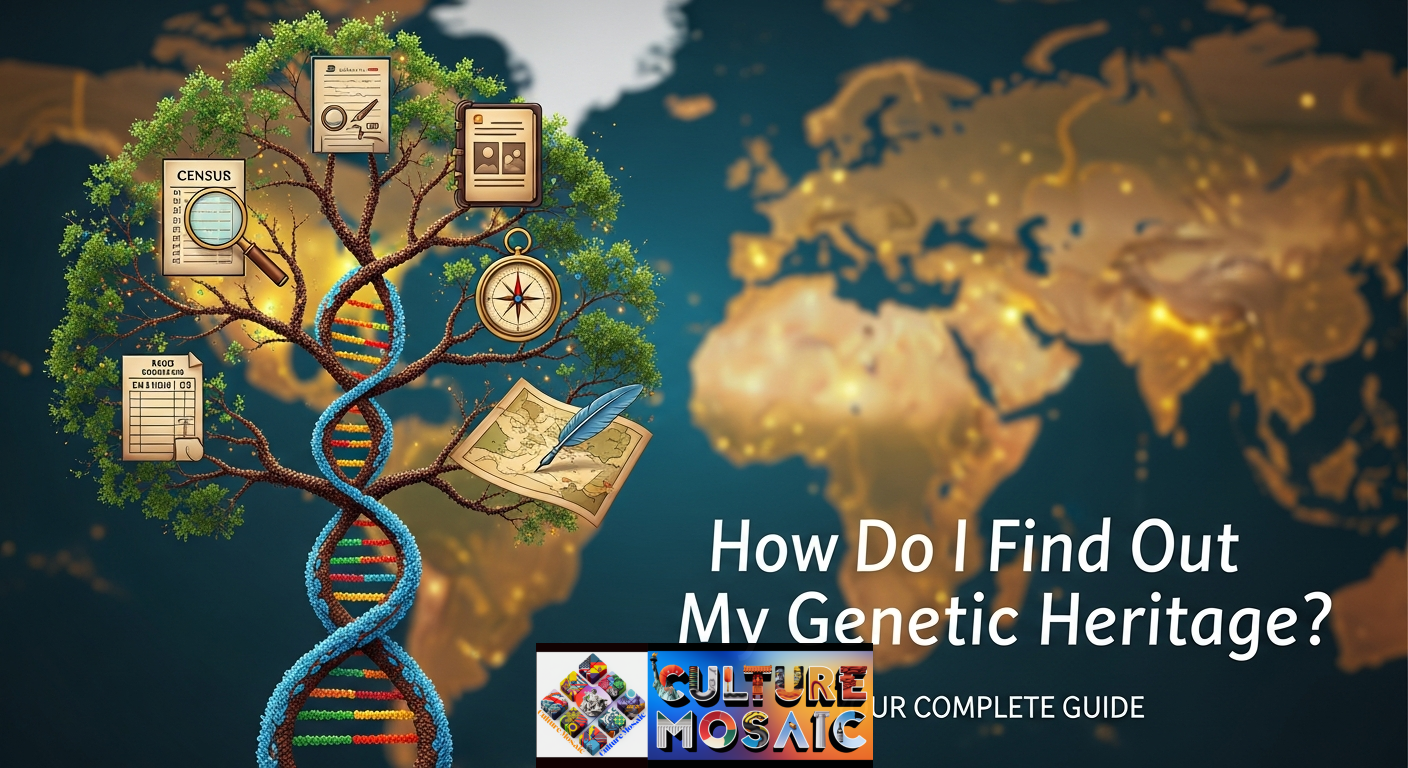How Do I Find Out My Genetic Heritage? You’ve probably wondered where your family really comes from. Maybe you’ve heard stories about a distant ancestor from Ireland or Italy, or perhaps you know almost nothing about your family’s past. Either way, you’re asking the same question thousands of people search for every day: how do I find out my genetic heritage?
The good news is that discovering your genetic heritage has never been more accessible. A simple DNA test can reveal connections to populations around the world, introduce you to relatives you never knew existed, and help you trace your family story back through generations. But getting real answers requires more than just spitting in a tube and waiting for results.
This guide walks you through everything you need to know, from picking the right DNA test to interpreting complex data and connecting your genetics to actual family history. Let’s get started.
Understanding What Genetic Heritage Really Means
Before you order a test, it helps to know what you’re actually looking for. Your genetic heritage refers to the geographic origins of your ancestors and the populations they belonged to. DNA testing reveals this by comparing your genetic markers to reference groups from around the world.
Here’s what’s important to understand: genetic heritage shows you biological ancestry, but it doesn’t define your cultural identity. You might discover genetic connections to Scandinavia, but that doesn’t automatically make you Norwegian in any cultural sense. The richest understanding of your heritage comes from combining genetic insights with family stories, historical research, and genealogical records.
Think of DNA testing as one powerful tool in a larger toolkit. It opens doors and provides clues, but the real discoveries happen when you start investigating what those clues mean.
How Do I Find Out My Genetic Heritage? Step 1: Choosing Your DNA Test

The first step in answering how do I find out my genetic heritage is choosing the right DNA test. The market is crowded with options, and they’re not all the same. Here’s what you need to know about the major players.
AncestryDNA: Best for Building Your Family Tree
AncestryDNA has the largest database in the game, with over 20 million users. That massive pool means you’re more likely to find relatives and connect with distant cousins who can help fill in your family tree.
What you get: Ethnicity estimates covering 2,600+ regions worldwide, DNA matches with potential relatives, integration with Ancestry’s genealogy records (census data, birth certificates, immigration documents), and family tree building tools.
What you don’t get: Health information or detailed haplogroup analysis.
Best for: People who want to build a detailed family tree and find living relatives.
23andMe: Best for Health Plus Ancestry
23andMe stands out because it combines ancestry with comprehensive health reports. You’ll learn about carrier status for genetic conditions, wellness traits, and how your genetics might affect your health.
What you get: Ethnicity estimates, haplogroup assignments (maternal and paternal), Neanderthal ancestry percentage, DNA relative matching, and detailed health reports (with the Health + Ancestry kit).
What you don’t get: The extensive genealogical record integration that Ancestry offers.
Best for: People who want both heritage information and health insights.
MyHeritage DNA: Best for International Research
MyHeritage excels at international reach, particularly for European ancestry. They support 42 languages and have strong databases outside the United States.
What you get: Ethnicity estimates covering 2,114 regions, DNA matching, family tree building tools, and access to international records.
Best for: People with European ancestry or non-English speaking family members.
FamilyTreeDNA: Best for Deep Ancestral Lines
FamilyTreeDNA offers the most comprehensive testing options, including specialized tests that trace your ancestry back thousands of years.
What you get: Autosomal DNA testing (recent ancestry), Y-DNA testing for direct paternal line (males only), mitochondrial DNA testing for direct maternal line (everyone), and a scientifically focused community.
Best for: People interested in ancient ancestry and deep genealogical research.
What Type of DNA Test Should You Get?
Most people start with an autosomal DNA test. This analyzes the DNA you inherited from both parents and reveals ancestry from all your recent ancestors (roughly 5-7 generations back, or about 150-200 years).
If you want to trace specific lineages deeper into history, consider Y-DNA testing (follows your father’s father’s father’s line, males only) or mitochondrial DNA testing (follows your mother’s mother’s mother’s line, available to everyone).
For most people wondering how do I find out my genetic heritage, an autosomal test from AncestryDNA or 23andMe gives you the best starting point. You can always add specialized tests later if you want to dig deeper.
Step 2: How Do I Find Out My Genetic Heritage? Understanding Your DNA Results

Understanding the data is key to knowing how do I find out my genetic heritage beyond simple numbers. Your results typically arrive 4-8 weeks after the lab receives your sample. Here’s how to make sense of what you see.
Reading Your Ethnicity Estimate
Your ethnicity estimate appears as percentages and colorful maps showing where your ancestors likely came from. If you see “35% Irish,” that means about 35% of your genetic markers match people whose families have lived in Ireland for many generations.
But here’s the reality check: these are estimates, not exact measurements. Different companies use different reference populations and different math, which is why you might get varying results from different services. One company might say you’re 30% Scandinavian while another says 25%. Both are working from the same DNA, just analyzing it differently.
Percentages below 5% often fall within the margin of error. That 2% Native American or 3% Nigerian might be real, or it might be statistical noise. The larger percentages (above 10-15%) are generally more reliable.
Also, remember that these results reflect populations from hundreds or even thousands of years ago, not modern political borders. “Italian” ancestry might show up as “Southern European” or be broken down into specific regions like Sicily or Tuscany, depending on how detailed the company’s reference database is.
The good news: your results for recent ancestry (past 5-7 generations) are pretty accurate. The further back you go, the fuzzier things get.
Understanding Haplogroups
If your test includes haplogroup information, you’re looking at your deep ancestral lines. Haplogroups trace either your direct maternal line (through your mother, her mother, her mother, and so on) or your direct paternal line (through your father, his father, his father, and so on).
These genetic lineages go back thousands of years and reveal ancient human migration patterns. For example, if your maternal haplogroup is H, your direct maternal line likely traces back to people who lived in Europe or the Near East thousands of years ago. If your paternal haplogroup is R1b, your direct paternal ancestors probably migrated into Western Europe during the Bronze Age.
Here’s what’s important to understand: haplogroups represent just two lines out of your many ancestors. You have two parents, four grandparents, eight great-grandparents, and so on. Haplogroups track one maternal line and one paternal line through this expanding tree. They’re fascinating for understanding ancient migrations, but they don’t tell your complete ancestry story.
Making Sense of DNA Matches
This is where things get really interesting. Your DNA matches are people who share segments of DNA with you, which means you have a common ancestor somewhere in your family trees.
The amount of shared DNA (measured in centimorgans, or cM) tells you approximately how closely related you are:
- Immediate family (parents, siblings, children): 2,400-3,400 cM
- First cousins: 680-1,150 cM
- Second cousins: 170-410 cM
- Third cousins and beyond: under 200 cM
Most people discover hundreds or thousands of matches, the vast majority being distant cousins (3rd to 6th cousins) they’ve never met. Don’t feel overwhelmed. You don’t need to contact everyone. Focus on closer matches or people who share your research interests.
These matches become incredibly valuable when you start building your family tree. If you and a DNA match both have the same great-great-grandparents in your trees, that confirms your research. If a match’s tree includes names you don’t recognize, you might have found a new branch of your family.
When Results Surprise You
DNA testing sometimes reveals unexpected information. You might discover your ethnicity is different from what family stories suggested. You might find close relatives you didn’t know existed. Some people learn about adoption, affairs, or other family secrets.
If your results surprise or upset you, give yourself time to process the information. Consider joining online communities where people share similar experiences. A therapist who specializes in DNA discoveries can help if you’re dealing with difficult emotions.
Step 3: How Do I Find Out My Genetic Heritage? Connecting Your DNA to Real Family History

This final step teaches you how do I find out my genetic heritage by weaving data with history. DNA results become meaningful when you connect them to actual people, places, and stories.
Starting Your Family Tree
Begin with what you know. Write down information about your parents, grandparents, and great-grandparents: full names (including maiden names), birth dates and places, marriage dates and places, death dates and places, and where they lived throughout their lives.
Then work backward, one generation at a time. Don’t skip around or leave gaps.
Using Historical Records
Now you need documentation to verify and extend what you know. Key resources include:
Vital records: Birth certificates, marriage licenses, and death certificates provide official documentation of major life events. Most are available through state or county vital records offices.
Census records: The U.S. The census has been carried out at ten-year intervals starting from 1790. These records show who lived in each household, their ages, birthplaces, occupations, and relationships. Censuses are released to the public 72 years after they’re taken (the most recent available is 1950).
Immigration records: If your ancestors immigrated to the U.S., ship manifests and passenger lists can tell you when they arrived, where they came from, who they traveled with, and where they were headed. Ellis Island records are searchable online for free.
Military records: Service records, pension files, and draft registrations provide details about ancestors who served in the military. These often include physical descriptions, family information, and residence details.
Church records: Before governments kept vital records, churches documented baptisms, confirmations, marriages, and burials. These records can be especially valuable for tracing ancestors in the 1700s and earlier.
Newspaper archives: Local newspapers published birth announcements, marriage notices, obituaries, and news about community members. Sites like Newspapers.com and Chronicling America provide searchable archives.
Most of these records are available through subscription genealogy websites like Ancestry.com, FamilySearch.org (which is free), MyHeritage, and Findmypast. Many libraries offer free access to these sites if you visit in person.
Linking DNA Matches to Your Tree
Here’s where your DNA matches become research partners. When you share DNA with someone, you share an ancestor. The challenge is figuring out which ancestor.
Start by looking at shared matches. If you, your second cousin Sarah, and your DNA match all share DNA with each other, you know the common ancestor is someone you and Sarah share (probably a great-grandparent or great-great-grandparent).
Build out the family trees of your matches (or look at their existing trees if they’ve shared them). When you find a surname or location that appears in both trees, you’ve likely found your connection point.
This detective work takes time, but it’s incredibly rewarding. You’re not just looking at percentages anymore. You’re discovering actual people who lived, loved, struggled, and made the choices that eventually led to you.
Researching Geographic Origins
Your ethnicity estimate tells you about regions, but historical records tell you about specific villages and towns. If your DNA says you’re 40% Italian, your research might reveal that your great-great-grandparents came from a small village in Calabria. That’s where the story becomes real.
Look for patterns in where your ancestors lived. Did they migrate from rural areas to cities during industrialization? Did they move west during the homesteading era? Did they flee religious persecution or economic hardship?
Understanding the historical context helps you understand your ancestors’ choices. They weren’t just names on a family tree. They were real people responding to real circumstances, and their decisions shaped your family’s path through history.
How Do I Find Out My Genetic Heritage? Navigating Privacy and Ethical Considerations

Navigating the ethical journey when seeking answers to how do I find out my genetic heritage requires careful thought about privacy and potential surprises.
Understanding What You’re Sharing
When you send DNA to a testing company, you’re sharing your most personal biological information. Read the privacy policy carefully. Understand how your data might be used, whether it can be shared with third parties, and what happens if the company is sold.
Some companies have cooperated with law enforcement to solve crimes using genetic genealogy. GEDmatch, for instance, allows law enforcement access under certain conditions. If this concerns you, research each company’s policies before testing.
You can protect yourself by opting out of research programs, using a pseudonym when possible, and understanding that you can download your data and delete your account later (though this doesn’t erase information that’s already been shared).
Preparing for Unexpected Discoveries
Studies suggest that about 2-10% of people discover unexpected information about their parentage through DNA testing. You might find out you have a half-sibling you never knew about. You might learn your father isn’t your biological father. You might discover adoption in your family that was kept secret.
These discoveries affect multiple people, not just you. If you find an unexpected close match, think carefully before reaching out. The other person might be equally shocked. They might welcome contact or they might prefer privacy.
If you discover something unexpected, give yourself time to process before making decisions. Consider talking to a therapist, especially one experienced with DNA discoveries. Join online support groups where people share similar experiences.
Being Culturally Sensitive
How Do I Find Out My Genetic Heritage? Finding out you have genetic heritage from a specific region doesn’t make you a member of that culture. Cultural identity comes from lived experience, community acceptance, and cultural knowledge, not DNA percentages.
This is especially important regarding Indigenous ancestry. Tribal membership is determined by documented lineage and tribal law, not DNA tests. Don’t claim membership in communities based solely on genetic results.
Approach newly discovered heritage with respect and humility. Learn about the culture, but don’t appropriate it or claim automatic membership. Listen to people from these communities about how they feel about genetic testing and ancestry claims.
How Do I Find Out My Genetic Heritage? Advanced Strategies for Serious Researchers
Once you’ve mastered the basics of how do I find out my genetic heritage, these advanced techniques can help you break through research roadblocks.
Testing Multiple Family Members
The more family members who test, the more information you gain. Testing your parents helps you determine which DNA segments came from which side of your family. Testing siblings, aunts, uncles, and cousins expands your match pool and helps identify shared ancestors.
If possible, test older relatives before it’s too late. They carry DNA from ancestors you’ll never be able to access otherwise.
Using Multiple Testing Companies
Each company has a different customer database. Someone who matches you might have tested with 23andMe but not Ancestry, or vice versa. Testing with multiple companies increases your chances of finding specific relatives.
You can also upload your raw DNA data from one company to other sites (where allowed). GEDmatch and MyHeritage both accept uploads from other companies, letting you access their databases without buying another test.
Chromosome Mapping
Advanced researchers create visual maps showing which ancestors contributed DNA to which chromosome segments. This technique, called triangulation, involves finding groups of people who all share the same DNA segment, indicating they inherited it from the same ancestor.
This gets technical quickly, but it’s powerful for identifying specific ancestral lines and confirming relationships.
Working with Professional Genealogists
If you hit a brick wall or have a complex question (like identifying an unknown parent), consider hiring a professional genetic genealogist. These specialists can solve problems that might take you years to figure out on your own. Expect to pay $30-200+ per hour, depending on the complexity of your case.
How Do I Find Out My Genetic Heritage? Staying Current with Your Research
Genetic genealogy evolves constantly. Companies update their ethnicity estimates as they improve their reference populations. New DNA matches appear as more people test. Scientific understanding of human genetics and migration continues to advance.
Join online communities through Facebook groups focused on genetic genealogy, specific surnames, or geographic regions. Follow genetic genealogy blogs and podcasts. Attend webinars offered by genealogical societies and DNA companies.
The most important thing is to stay engaged with your research. Check your DNA matches regularly. Keep building your family tree. Keep learning about the historical context of your ancestors’ lives.
How Do I Find Out My Genetic Heritage? Final Thoughts on Finding Your Genetic Heritage
So, how do I find out my genetic heritage? The answer involves three interconnected steps: taking a DNA test to reveal your genetic connections, interpreting the data to understand what those connections mean, and linking your genetics to historical records to discover the actual stories of your ancestors.
Your genetic heritage is more than percentages on a screen. It’s a bridge connecting you to real people who lived through wars, migrations, love stories, and everyday struggles. Every ancestor you discover opens a window into a different time and place.
This journey takes patience. Building a thorough family tree isn’t a weekend project. It takes years of careful research, detective work, and occasional lucky breaks. But the rewards go beyond just filling in names and dates on a chart.
Understanding your genetic heritage connects you to the vast sweep of human history and shows you exactly where you fit in that story. It reveals the resilience, courage, and determination of the people who came before you. And it reminds you that you’re part of an unbroken chain of ancestors stretching back thousands of generations, each one surviving long enough to pass life forward to the next generation, ultimately leading to you.
That understanding, more than any ethnicity percentage or haplogroup assignment, is the real answer to how you find out your genetic heritage.
Frequently Asked Questions About How Do I Find Out My Genetic Heritage?
Q: How accurate are DNA tests for finding genetic heritage?
A: DNA tests are quite accurate for identifying your genetic connections to populations and regions, especially for ancestry within the past 5-7 generations (about 150-200 years). However, ethnicity estimates are just that – estimates. Different companies may give you somewhat different percentages because they use different reference populations and algorithms. Percentages above 10-15% are generally reliable, while smaller percentages (under 5%) may fall within the margin of error. DNA matching with relatives is very accurate – if the test says you share DNA with someone, you definitely share a common ancestor.
Q: Which DNA test is best for finding out my genetic heritage?
A: The best test depends on your goals. AncestryDNA has the largest database (20+ million users), making it best for finding relatives and building your family tree. 23andMe is ideal if you want both ancestry and health information. MyHeritage works well for European ancestry and international research. FamilyTreeDNA offers the most options for tracing deep ancestral lines through Y-DNA and mitochondrial DNA testing. For most people starting their journey, AncestryDNA or 23andMe provides the best combination of features and database size.
Q: How long does it take to get DNA test results?
A: Most DNA testing companies take 4-8 weeks to process your sample and deliver results after they receive your kit. The actual testing takes a few weeks, and processing time varies depending on how many people are testing at once (holiday seasons often see delays). You’ll typically receive an email notification when your results are ready, and you can view them by logging into your account on the company’s website.
Q: Can DNA testing tell me about specific countries my ancestors came from?
A: DNA tests can identify the general regions your ancestors came from, but they work with populations, not modern political borders. Your results might show “Ireland” or “Italy,” but what they’re really saying is that your DNA matches people whose families have lived in those regions for many generations. To pinpoint specific villages or towns, you’ll need to combine your DNA results with traditional genealogy research using historical records like census data, immigration documents, and birth certificates. The DNA gives you the regions; the records give you the specific locations.
Q: What should I do if my DNA results don’t match what I expected?
A: Unexpected results are common and can happen for several reasons. Family stories aren’t always accurate – oral history often gets details wrong or simplified over generations. You might discover your ethnicity is different from what family lore suggests, or you might find unexpected relatives indicating adoption, affairs, or other family secrets. Give yourself time to process surprising information. Consider joining online support communities for people with similar DNA discoveries. If you’re struggling emotionally, a therapist experienced with genetic discoveries can help. Remember that genetic heritage shows biological ancestry, which is just one part of your identity. Your life experiences, cultural upbringing, and chosen identity matter just as much as your DNA.

